




|
|

Led by Larry Cartwright
Real-World Course Leaps into
Muck of Construction
Seniors in engineering and other studies prepare for careers in practical, hands-on projects that benefit the campus.
Text by Ann Curran, Photos by Bill Redic and Glenn Brookes
You can't miss Larry Cartwright on a construction site. At 6 foot 6 and 300 pounds, he towers above his students, all dressed in white hard hats. Now in his 15th year as teacher in the enormously practical Design and Construction course, Cartwright (E'76, '87) has taken his students from early non-glamorous "pure engineering" jobs, such as building cleaning tanks and retaining walls, to constructing decks, parklets and amphitheaters that clearly contribute to the ambience of outdoor life on campus.
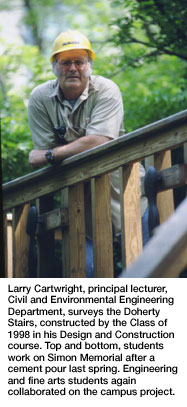 This year's project—a memorial to the late professor and Nobel laureate Herbert A. Simon—just started, like Cartwright's class, on Jan. 14.
This year's project—a memorial to the late professor and Nobel laureate Herbert A. Simon—just started, like Cartwright's class, on Jan. 14.
"I have a real eclectic group," Cartwright says, at the Baker Hall site as students hammer together wooden forms in preparation for a cement pour. Lapsing into engineering college shorthand, he says, "I have 18 civils, three mechanical engineering, one electrical engineering, one materials scientist, two sculptors, one architect.... I actually recruited people from Fine Arts."
All students take part in both the design and construction phases in this very popular course.
"The design crew had an architect, three civils, a mechanical, an electrical and a sculpture student," Cartwright notes. "I force them to work together. I want them to get used to working with different disciplines because that's what they're going to do for the rest of their lives."
The completed Simon Memorial will have a slightly subterranean feel with a circular concrete structure with cantilevered seats. A 50-foot band of granite with three right angles will display the following statement by Dr. Simon: "Learning results from what the student does and thinks, and only from what the student does and thinks. The teacher can advance learning only by influencing what the student does to learn."
It's an eye opener
Herbert A. Simon Memorial-2002
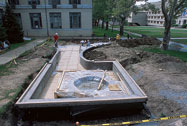 "I really like this course. It's a lot of fun. It's not your typical class because you actually get to design something. There's not a set class period when you have to go to a lecture. It's pretty much student-run. Larry does a lot of the advising. Everything that we use has already been taught to us. We apply it. A lot of us don't know that much about construction. It's an eye opener."
"I really like this course. It's a lot of fun. It's not your typical class because you actually get to design something. There's not a set class period when you have to go to a lecture. It's pretty much student-run. Larry does a lot of the advising. Everything that we use has already been taught to us. We apply it. A lot of us don't know that much about construction. It's an eye opener."
Owen Silbaugh E'02
Paul C. Rizzo Associates, Columbia, S.C.
"I love this course. I've been waiting all my college career to take it. [I've learned] so much about construction. Just so many little things that you never learn in a class. When we broke ground, we ran into so many different types of pipes, all those things that weren't on the map. They tell you in class, oh, you'll be surprised what you find when you dig, but when you really break gas lines because they're not on the map, that's when you really learn. And I didn't know anything about forms. I just knew they were pieces of wood that you poured concrete in but didn't know about all the stiffeners and bracers. I learned so much."
Matt Coelho E'02
"[This] is probably the best class I've ever taken. [I've learned] a lot of stuff about how to take a project and put it in a real-world setting. Realizing a lot of the principles and stuff that we've been learning in our courses in the last few years isn't maybe the most important thing. The most important thing is being able to think and to use it. I like the fact that there's a lot of responsibility on us in the project. If we don't show up or if we don't get something done, then we're in trouble."
Stacie Hogya E'02,
Engineering Consultant
Duggan & Rhodes LLC, Pittsburgh
|
Learning what you can't teach in the classroom
What do students learn in this course, which began with a suggestion from Chris T. Hendrickson, head of Civil and Environmental Engineering? "The best-laid plans go asunder," responds Cartwright, who has taught at Carnegie Mellon for 23 years on the lecture rather than tenure track for faculty whose primary interest is teaching. The Design and Construction course is "diametrically opposed" to Cartwright's own experience as an engineering student at Carnegie Mellon. "There is so much practical. Just everything," he says. "How to schedule, how to use tools, how to work with people. Just everything you can't teach in a classroom. Lots of the technical parts, too, because the students have to design all this." And, he adds, the projects "are really designed well. In fact, they're over-designed [lots of detail on what to do] because I have to allow for the fact that most of these kids are unskilled. While they are almost engineers, some of them have never used an electric drill before. I have to bring them up on the learning curve."
Cartwright, who first worked in construction himself at 16 in his father's firm, tries to pick projects that use the background students are learning in their core courses. He gets lots of projects suggested—often for work in somebody's backyard. But, he says, "the groups are not just builders. They're engineers and designers. I'm not going to put sidewalks in for anyone. Anyone can do that. I take things that will challenge."
The Class of 1998's Doherty Stairs remains Cartwright's most challenging and favorite project. And he did it as a favor to his friend Joe Mannino, associate professor of art. Mannino apparently pointed out to Cartwright all the arts students scampering up the hillside from the studios in the subbasements of Doherty Hall to The Cut. That's a 44-foot ascent, and there was no convenient outdoor way to get up.
Teacher wears a hard hat
Doherty Stairs-1998
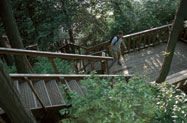 "Even if it's just a bunch of students digging with shovels, Larry [Cartwright] is always looking to teach and provide real-world know-how. It's
always a test, except this time the teacher's wearing a hard-hat. It's extremely helpful for those who go into design or construction because it shows the critical link between the two by requiring students to participate in both. There was always the opportunity to step up, take on more responsibility and enhance the final product. Even if students choose different career paths than design/construction, they learn more about responsibility in group settings and have a sense of pride knowing that they left a permanent fixture at an important place in their lives.
"Even if it's just a bunch of students digging with shovels, Larry [Cartwright] is always looking to teach and provide real-world know-how. It's
always a test, except this time the teacher's wearing a hard-hat. It's extremely helpful for those who go into design or construction because it shows the critical link between the two by requiring students to participate in both. There was always the opportunity to step up, take on more responsibility and enhance the final product. Even if students choose different career paths than design/construction, they learn more about responsibility in group settings and have a sense of pride knowing that they left a permanent fixture at an important place in their lives.
"I'm proud of what my class accomplished and the link it provides to the lower campus. It was satisfying to build something that was tucked away on campus, that is almost a part of the land winding its way through the trees.
"I gained more insight into my responsibility and accountability as part of a group and the effect of my actions. [I learned that] just because you can design it doesn't mean you can build it. I increased my confidence in my own abilities to design, deal with quickly changing parameters and take charge. I learned to deal with real-life pressures like budget concerns, timelines and public safety."
Tony Ream E'98,
Structural Engineer
HDR Engineering Inc., Pittsburgh
|
"I went to [campus architect] Paul Tellers," Cartwright recalls, "and I said, 'Paul, I'm going to build some steps for the hillside. You should pay for them.'"
That project ran beyond commencement and through June because of a rainy April.
"We worked in the rain, but it was really inefficient," Cartwright says. "I must have fallen 200 times on the hillside."
The steepness of the hillside meant the students had to use a series of ropes to pull themselves up. It also meant the job required switchbacks—zigzag changes in direction—in the stairs. With the staggered landings and changes in direction, you can climb the hill quickly without tiring. "The kids designed it such that they did not remove a single tree," Cartwright points out.
Cartwright is proud of the expensive treads on the stairs. They have openings that snow can fall or melt through in the winter. In addition, steel points, about a half inch high, project from the steps, providing a good grip againstfootwear.
Making campus inviting
At first, people around campus hesitated about funding student projects. But, says Cartwright, "after a few years, they realized, 'Gee, this is a pretty good product.' And, 'Gee, it's really cheap.'" While he had to lean on his friend "Red" Whittaker (E'75), the Fredkin research professor in the Robotics Institute, to fund the first project, nowadays there's a queue of projects waiting.
My first interdisciplinary project
Amphitheater-2000
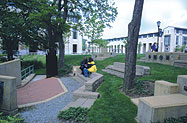 "Design and Construction was, by far, the best course I took at Carnegie Mellon. It combined book knowledge from four years of classes, a tremendous amount of teamwork and hands-on work. The class learned to work with students of different disciplines including art majors, architects and engineers. This was my first exposure to a true interdisciplinary project.
"Design and Construction was, by far, the best course I took at Carnegie Mellon. It combined book knowledge from four years of classes, a tremendous amount of teamwork and hands-on work. The class learned to work with students of different disciplines including art majors, architects and engineers. This was my first exposure to a true interdisciplinary project.
"Larry emphasized the importance of hard work and teamwork. He taught us what it takes to work on a complex project. I learned how a designer must take into consideration every angle of every form so that it is still constructible. I learned how a project manager must keep the entire project team together as a cohesive group. The hands-on experience of making forms, bending REBAR [steel reinforcing bars], finishing concrete and utilizing the final product has been an invaluable experience for me. Being employed in a construction field, I use the practicality of the course every day. The vigorous time frame imposed by a semester class is a very realistic scenario."
Kendra Grompone E'00, Lead Engineer, Design-Build
Public Service Electric & Gas Company, Newark, N.J.
"I looked forward to the class throughout my first three years and couldn't wait to have the opportunity to contribute to the built environment at Carnegie Mellon. We got to see our project from start to finish. Usually, you only get to play one role, but we went all the way from developing a concept to enjoying a finished product. The only things I would change about the experience are the same things I would change about construction projects I've been involved in since college. Engineers working with contractors know the frustrations of ignored drawings and having to stick to schedules despite mistakes, and contractors know the frustrations of unclear designs and changes that slow the schedule. I learned how to work with other players in a construction project (architects, engineers and contractors) and the importance of considering how something is going to be built in addition to what it's supposed to look like when it's done."
Erin Rockwell E'00, Engineer
Building Technology Division, Simpson Gumpertz & Heger Inc.,
Consulting Engineers, Arlington, Mass.
|
Cartwright not only teaches the class and oversees the construction, he goes out on campus and gets a client and cash for the projects. For this year's project, he approached the Faculty Senate. They agreed to help, and, Cartwright says, "I strong-armed Jeff Bolton [then vice president for business and planning and chief financial officer] to pay for the rest." This year's project will cost $32,000. Over the years, Cartwright estimates, projects have cost a total of $250,000. He believes that if the university had hired outside architects, engineers and construction companies to do the same projects, it would have cost $1 million.
While Campus Architect Tellers says he's not always sure of what's going to be built because of the time constraints of the course and Cartwright's pedagogical objectives that often include concrete and wood, "we have always hammered out an agreement."
It was more fun than work
Scotty's Corner-1999
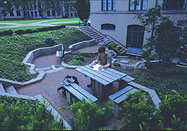 "Design and Construction was the course I enjoyed the most. It took a lot of time and effort but was well worth the long hours and labor. To be so heavily involved in the direction of the course and project is something that you just don't get every day at any institution. The course was so well thought-out and planned that it made you look forward to having class and working. It was more fun than work, which is a rarity these days.
"Design and Construction was the course I enjoyed the most. It took a lot of time and effort but was well worth the long hours and labor. To be so heavily involved in the direction of the course and project is something that you just don't get every day at any institution. The course was so well thought-out and planned that it made you look forward to having class and working. It was more fun than work, which is a rarity these days.
"Everything I got from the Design and Construction course I use every day in my job. Look-ahead planning, sequence of work, lean construction, day-to-day operations of a project are things I deal with on a daily basis. Physically performing all of the work also gave me an appreciation of what the field labor forces actually go through."
Jeff Poore E'99, Project Manager
Southland Industries Washington, D.C.
|
The projects, created largely by graduating senior engineers, have, Tellers notes, increased the outdoor social and meeting spaces on campus, making it more pedestrian friendly in keeping with the university's master plan. That plan, which looks more than 20 years ahead, calls for more of the open green spaces recommended by the original campus architect Henry Hornbostel. Tellers is particularly impressed with the Amphitheater between Doherty Hall and the Purnell Center for the Arts. Part of it looks out over the trees on the hill; part looks up to an area with seating at various heights. This project also contains some whimsical animal sculptures by William Kofmehl, later to become legendary on campus and beyond as "Lobster Boy."
Most reactions to the projects are generally good. But "not everything we do is appreciated," admits Cartwright. "There's always two percent naysayers that pick it apart. I just basically try to be patient" and refrain from obscenities, he says. "I've had at least one heart attack [in 1993] over this course," Cartwright says, mentioning his 70-, 80-, 90-hour workweeks. And there was a second minor one. He doesn't usually join in the physical work of the projects now. But he's certainly there directing every minute. "Everyone worries about me," he says. "The object is to get the project done and keep me alive."
Bonding experience
Doherty Pavilion-2001
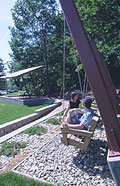 "We've all heard horror stories from past seniors, but in the end Design and Construction was a great experience. It was hard work, but we learned so much about actually building something rather than just drawing it on paper. It was a huge bonding experience for our class. It didn't seem so much like work as it did like just hanging out and having a good time. When it was finished, it was such a good feeling to sit back and think I helped to build that.
"We've all heard horror stories from past seniors, but in the end Design and Construction was a great experience. It was hard work, but we learned so much about actually building something rather than just drawing it on paper. It was a huge bonding experience for our class. It didn't seem so much like work as it did like just hanging out and having a good time. When it was finished, it was such a good feeling to sit back and think I helped to build that.
"If I could change anything [about the experience], it would be that I would have gotten even more involved and learned as much as I could have. It's a very unique class and a unique opportunity to learn things outside of a classroom. I think the skills I use most are just the general communication and teamwork skills that I developed while in Larry's class."
Heather Blair E'01, Civil Associate I
Michael Baker Jr. Inc., Coraopolis, Pa.
|
Perhaps the clearest salute to the student projects comes from the people on campus. They eat lunch, sip soda, cram for exams at Scotty's Corner, a seven-level concrete and brick hangout that meanders down the hillside to a below-grade doorway to Doherty Hall. They hang around at the Amphitheater chatting with friends. They lead their favorite guy or gal down to a semiprivate leafy landing with a built-in bench on the Doherty Stairs. They rock gently, learning to relax from learning, at the world's most well-supported swings in the Doherty Pavilion. Yep, as their teacher might say, those kids do all right.
More: www.cit.cmu.edu/ugweb/e_ugweb_proj.html
Larry Cartwright in a nutshell
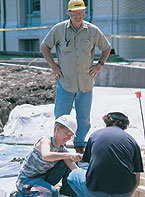 Engineering students expect to enjoy a Larry Cartwright course, and they learn from it. Besides the Design and Construction course that has resulted in engineers with a firm grasp on reality, not to mention the addition of so many cozy corners on campus, the professor is known for his Civil and Environmental Engineering Design course, which he teaches with other faculty.
Engineering students expect to enjoy a Larry Cartwright course, and they learn from it. Besides the Design and Construction course that has resulted in engineers with a firm grasp on reality, not to mention the addition of so many cozy corners on campus, the professor is known for his Civil and Environmental Engineering Design course, which he teaches with other faculty.
Besides three "serious" projects per course, the class is remembered by most for the fourth "goofy" project, as Cartwright terms it. Over the years, students have engineered a Rube Iceberg (a la Rube Goldberg) Pie Delivery System. It involved a moving ball, a toy on a track, a bowling ball, an ice bridge, a boxing glove, a torch, a string and a weight. Bottom line: Cartwright repeatedly took a pie in the face.
In another project, Mobile Cow Tossing, Cartwright dressed in a black-and-white hard hat with horns. On his Holstein-patterned chest hung pink balloon udders. For this project, students built a trebuchet, or catapult, used in the 15th century to toss dead cows into castle grounds to spread disease. The assignment included placing the catapult on a floating structure and launching a 20-pound cow some 45 yards.
Here's what Cartwright's former students say about him:
"Larry Cartwright is hands down the best teacher I have ever had and one of the best people I have ever known. He is strict and his classes are tough, but he teaches you to take pride in your work and gives you a great sense of worth."—Jeff Poore E'99
"He's great."—Owen Silbaugh E'02; "Influential."—Tony Ream E'98; "Wholeheartedly committed to Carnegie Mellon and his students."—Erin Rockwell E'00; "Insightful."
—Heather Blair E'01; "Supportive."—Mary Wall E'98
"He's big. And he knows a lot. I can't think of a word that describes someone who knows everything about everything because that's about it."—Matt Coelho E'02
"He treats us with more respect than any faculty has ever treated a group of students. He has a lot of faith in our ability and wants us to take away the most we can from this course or any course I've had with him."—Stacie Hogya E'02
"For four years, Larry Cartwright was a teacher, a mentor and a friend to all the students in the Civil and Environmental Engineering Department. He always had confidence in us, believed in us and, most importantly, helped us to become mature, competent engineers. Larry brought a practical and real-world approach to engineering, and I think that makes any Carnegie Mellon student fortunate enough to have been taught by him a better engineer. I'd just have to describe him as 'the best.'"—Kendra Grompone E'00
|
> Back to the top
> Back to Carnegie Mellon Magazine Home
|



 This year's project—a memorial to the late professor and Nobel laureate Herbert A. Simon—just started, like Cartwright's class, on Jan. 14.
This year's project—a memorial to the late professor and Nobel laureate Herbert A. Simon—just started, like Cartwright's class, on Jan. 14.
 "I really like this course. It's a lot of fun. It's not your typical class because you actually get to design something. There's not a set class period when you have to go to a lecture. It's pretty much student-run. Larry does a lot of the advising. Everything that we use has already been taught to us. We apply it. A lot of us don't know that much about construction. It's an eye opener."
"I really like this course. It's a lot of fun. It's not your typical class because you actually get to design something. There's not a set class period when you have to go to a lecture. It's pretty much student-run. Larry does a lot of the advising. Everything that we use has already been taught to us. We apply it. A lot of us don't know that much about construction. It's an eye opener." "Even if it's just a bunch of students digging with shovels, Larry [Cartwright] is always looking to teach and provide real-world know-how. It's
always a test, except this time the teacher's wearing a hard-hat. It's extremely helpful for those who go into design or construction because it shows the critical link between the two by requiring students to participate in both. There was always the opportunity to step up, take on more responsibility and enhance the final product. Even if students choose different career paths than design/construction, they learn more about responsibility in group settings and have a sense of pride knowing that they left a permanent fixture at an important place in their lives.
"Even if it's just a bunch of students digging with shovels, Larry [Cartwright] is always looking to teach and provide real-world know-how. It's
always a test, except this time the teacher's wearing a hard-hat. It's extremely helpful for those who go into design or construction because it shows the critical link between the two by requiring students to participate in both. There was always the opportunity to step up, take on more responsibility and enhance the final product. Even if students choose different career paths than design/construction, they learn more about responsibility in group settings and have a sense of pride knowing that they left a permanent fixture at an important place in their lives.
 "Design and Construction was, by far, the best course I took at Carnegie Mellon. It combined book knowledge from four years of classes, a tremendous amount of teamwork and hands-on work. The class learned to work with students of different disciplines including art majors, architects and engineers. This was my first exposure to a true interdisciplinary project.
"Design and Construction was, by far, the best course I took at Carnegie Mellon. It combined book knowledge from four years of classes, a tremendous amount of teamwork and hands-on work. The class learned to work with students of different disciplines including art majors, architects and engineers. This was my first exposure to a true interdisciplinary project.
 "Design and Construction was the course I enjoyed the most. It took a lot of time and effort but was well worth the long hours and labor. To be so heavily involved in the direction of the course and project is something that you just don't get every day at any institution. The course was so well thought-out and planned that it made you look forward to having class and working. It was more fun than work, which is a rarity these days.
"Design and Construction was the course I enjoyed the most. It took a lot of time and effort but was well worth the long hours and labor. To be so heavily involved in the direction of the course and project is something that you just don't get every day at any institution. The course was so well thought-out and planned that it made you look forward to having class and working. It was more fun than work, which is a rarity these days.
 "We've all heard horror stories from past seniors, but in the end Design and Construction was a great experience. It was hard work, but we learned so much about actually building something rather than just drawing it on paper. It was a huge bonding experience for our class. It didn't seem so much like work as it did like just hanging out and having a good time. When it was finished, it was such a good feeling to sit back and think I helped to build that.
"We've all heard horror stories from past seniors, but in the end Design and Construction was a great experience. It was hard work, but we learned so much about actually building something rather than just drawing it on paper. It was a huge bonding experience for our class. It didn't seem so much like work as it did like just hanging out and having a good time. When it was finished, it was such a good feeling to sit back and think I helped to build that.
 Engineering students expect to enjoy a Larry Cartwright course, and they learn from it. Besides the Design and Construction course that has resulted in engineers with a firm grasp on reality, not to mention the addition of so many cozy corners on campus, the professor is known for his Civil and Environmental Engineering Design course, which he teaches with other faculty.
Engineering students expect to enjoy a Larry Cartwright course, and they learn from it. Besides the Design and Construction course that has resulted in engineers with a firm grasp on reality, not to mention the addition of so many cozy corners on campus, the professor is known for his Civil and Environmental Engineering Design course, which he teaches with other faculty.